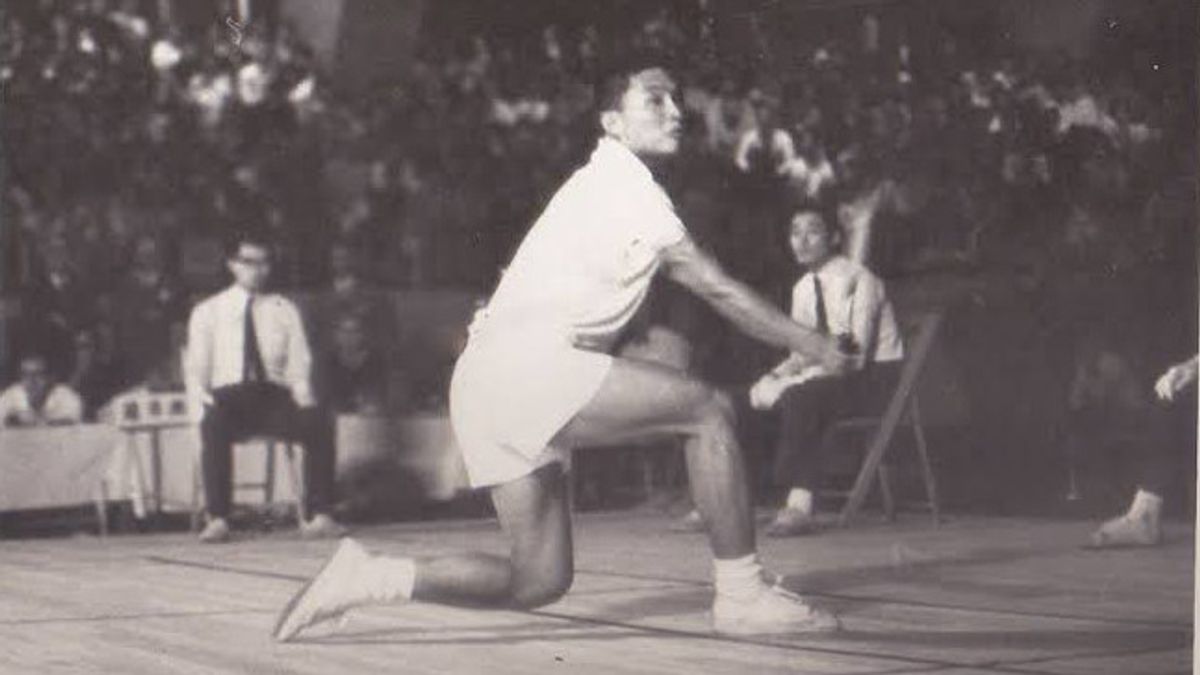JAKARTA - Tan Joe Hok is a legend of Indonesian badminton. Tan Joe Hok won many world competitions. He led the Indonesian team to win the Thomas Cup three times (1958, 1961 and 1964), the 1962 Asean Games and the 1959 All England. Tan Joe Hok's record at All England was special because he was the first title won by Indonesia.
Behind it all, Tan Joe Hok lived in a lackluster life. He doesn't have a racket or he doesn't know any technique. One of the ways Tan Joe Hok trains playing speed is precisely from boxing matches. Thanks to his tireless efforts, Tan Joe Hok became an invincible player. He was nicknamed: The Giant Killer (giant killer).
Tan Joe Hok was born in Bandung on August 11, 1937. He is the second of six children. His father, Tan Tay Ping, worked as a textile trader who often left home to look for some coffers of income. The life of Tan Joe Hok and his family is just barely enough and it gets even more difficult when his family starts to move life as a result of the war for independence.
He had visited Bandung, Sumedang and Tasikmalaya. His nomadic life made him good at observing his surroundings, including observing his parents playing badminton with their neighbors. Tan Joe Hok's interest in playing badminton started to escalate when he lived back in Bandung. At his residence at Jalan Satria 15, Cicendo, Bandung, his father built a simple badminton court, with field lines made of bamboo.

“Every day the field is never empty. From morning to evening, family and neighbors take turns playing badminton there. I, who was 13 at the time, was just an onion assigned to bring shuttlecock and a racket. The frequency of watching it made my interest in playing badminton even bigger. Unfortunately, I don't have a racket. As a substitute for a racket, I use my mother's kelom (wooden sandals). With the kelom and how come the three pieces of hair are left, I often invite our maid, Mang Syarif, to play badminton together, "said Tan Joe Hok quoted by Nunuy Nurhayati in his writing in Tempo Magazine entitled Tan Joe Hok Perintis at the Badminton Stage (2009).
Despite playing with makeshift tools, Tan Joe Hok began to show talent in badminton. Tan Joe Hok ventured to borrow his father's racket. Using the borrowed racket, many people who have been good at playing badminton are easily defeated by Tan Joe Hok. With that racket, Tan Joe Hok also won many local level matches.
People later praised his fast-paced way of playing. Even though at that time Tan Joe Hok did not understand the technique. Tan Joe Hok admits the key to his fast movement is in the leg movements, which he learned from boxing matches in Bandung. He was very impressed by the footwork of the boxers. Tan Joe Hok imitated the move by practicing skiping. Increasingly, the intensity of playing with family is getting higher.
“In small countries in the far east, badminton is a national sport, it is taken very seriously. Tan Joe Hok learned to hit with shuttlecock playing in the thatched yard against his father, mother and three sisters. "Quickly, Tan Joe Hok mastered all the basic badminton shots, he also developed a badminton slicing punch which is difficult to return," wrote a report in Life magazine entitled Indonesian Wins At Badminton (1959).
Victory after victory
The path of Tan Joe Hok to become a professional badminton player was opened by the famous badminton player from Bandung, Lie Tjoe Kong. Lie became the first professional to sniff out the talent of Tan Joe Hok. After that, Tan Joe Hok was invited to join the Blue White badminton team, which was the forerunner of the Mutiara Bandung Club. Long story short, the name Joe Hok became increasingly known after becoming a champion in the Surabaya national badminton championship in 1956.
That success brought him into the Indonesian team for the Thomas Cup tournament. The tournament took place in Singapore in 1958. The Indonesian team at that time was full of stars with the addition of Tan Joe Hok. His colleagues in the Indonesian team were Ferry Sonneville, Tan King Gwan, Njoo Kim Bie, Lie Poo Djian, Olich Solichin, and Eddy Yusuf. Thanks to the brilliance of the Indonesian team at the Thomas Cup, the team was nicknamed: The Magnificent Seven.
“On June 15, 1958, for the first time, the Indonesian badminton team managed to steal the Thomas Cup, which has become a symbol of international badminton supremacy. The Indonesian team managed to beat Team Malaya with a 6-3 point. The arrival of the team consisting of Ferry Sonneville (captain), Tan Joe Hok, Lie Poo Djian, Tan King Gwan, Njoo Kim Bie, Eddy Jusuf, Tio Tjoe Djen, Tan Thiam Beng, Rameli Rikin (non-playing captain), and R. Jusuf (team manager) at Kemayoran Airport received a warm welcome from the residents of Jakarta, ”Benny G. Setiono in the Chinese book in Pusaran Politik (2003).
The excitement of the welcoming was seen along the road from Kemayoran Airport to the Merdeka Palace. Arriving at the Merdeka Palace, the entire Indonesian team was immediately greeted by President Soekarno. It was at that moment that Tan Joe Hok and his friends were crowned heroes of Indonesian badminton. Ultimately, because while playing in the Thomas Cup, the Indonesian team became a dark horse.
The Indonesian team was underestimated. Nevertheless, the Indonesian team managed to overthrow all of its opponents. Not only that, the legitimacy of the strength of Indonesian badminton was again shown by Indonesian badminton players when they participated in the prestigious 1959 All England Championship.
In the final of the championship, the 'all Indonesian final' took place between Tan Joe Hok and Ferry Sonneville. Tan Joe Hok then came out as the winner and became the first Indonesian to win the All England. Thus, Indonesia began to be respected by the world.
"After that, it started with the All Indonesian Final between Tan Joe Hok and Ferry in the most prestigious championship at that time - All England - the name of Indonesia sticking out in the international world. Indonesian players have become respected. A new country that was strong in badminton was born, accompanying the countries of the United States (which later drowned), England, Denmark, Malaya, and Thailand. The era of badminton for Indonesia has begun to unfold, "added Brigita Isworo L and TD Asmadi in the book 1000 Tahun Nusantara (2000).
* Read other information about BURU TANGKIS or read other interesting articles from Detha Arya Tifada.
MEMORY OtherThe English, Chinese, Japanese, Arabic, and French versions are automatically generated by the AI. So there may still be inaccuracies in translating, please always see Indonesian as our main language. (system supported by DigitalSiber.id)











